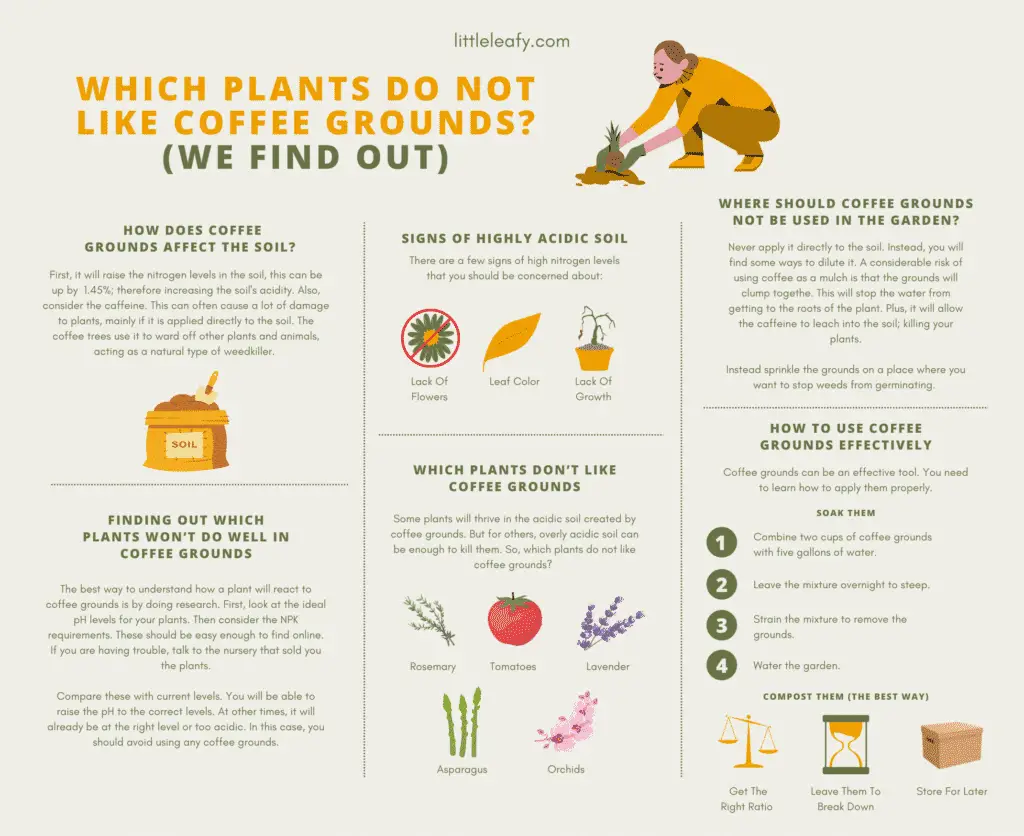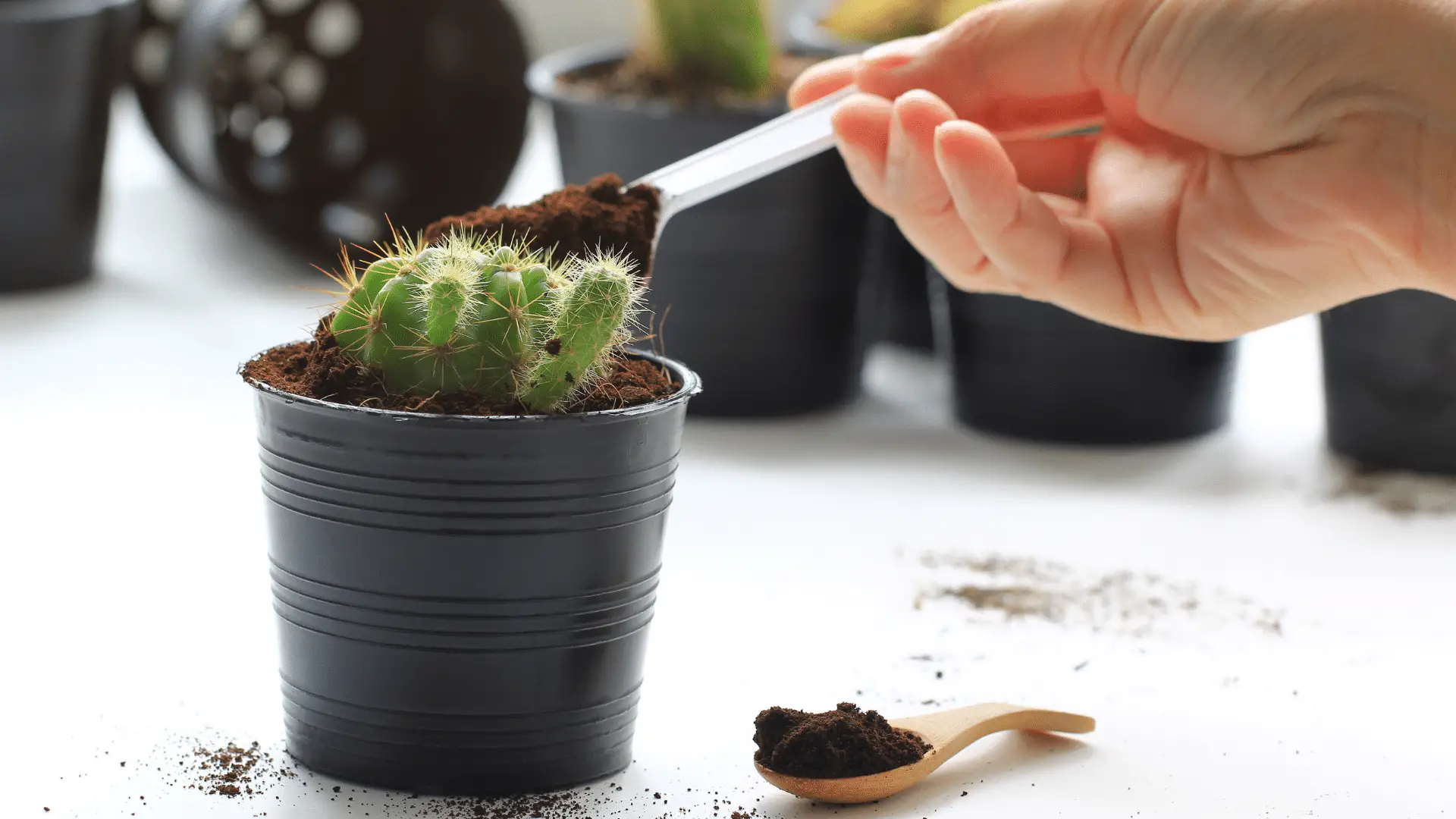Reading Time: 5 minutes 🍃
Coffee grounds can be a great source of nutrients. Because of this, they are a great addition to a compost heap. However, not every plant in your garden will thrive with the use of coffee grounds. So, which plants won’t like coffee grounds?
It’s best to avoid using coffee grounds with plants that don’t like acidic soil or high nitrogen levels in the soil. Some prominent examples of these plants include; tomatoes, rosemary, lavender, and asparagus.
You need to think about your plant’s needs when deciding what type of fertilizers you will use. Keep reading to learn more about when to avoid using coffee grounds.

How Does Coffee Grounds Affect the Soil?
The first thing that we need to understand is the way that coffee grounds affect the soil. This will give us a better idea of the type of plants that will live in these conditions. First, it will be able to raise the nitrogen levels in the soil. Sometimes, this can be as dramatic as a 1.45 percent increase .
.
As a result, the acidity of the soil will increase. This is the main area that we will focus on. It will often determine whether a plant will thrive or die when coffee grounds are used as a fertilizer.
To better understand the effects on the plants, it’s a good idea to start by testing your soil. There are two tests that you will need to perform. First, you will need to check the pH level. This will tell you how acidic the soil is.
It’s also a good idea to check the NPK levels. This refers to the amount of essential nutrients nitrogen, phosphorus, and potassium contained within the soil. You should be able to find both of these tests in your local hardware store.
Another element to consider is caffeine. This can often cause a lot of damage to plants, mainly if it is applied directly to the soil. The coffee trees use it to ward off other plants and animals, acting as a natural type of weedkiller .
.
Which Plants Don’t Like Coffee Grounds
Some plants will thrive in the acidic soil created by coffee grounds. But for others, overly acidic soil can be enough to kill them. So, which plants do not like coffee grounds?
Check out: Pruning Lavender
Finding Out Which Plants Won’t Do Well in Coffee Grounds
It should be noted that this isn’t an exhaustive list. The best way to understand how a plant will react to coffee grounds is by doing a little research. Start by looking at the ideal pH levels for your plants .
.
Then consider the NPK requirements. These should be easy enough to find online. If you are having trouble, talk to the nursery that sold you the plants.
Next, you’ll need to compare these with current levels. Sometimes, using coffee grounds can be a good idea. You will be able to raise the pH to the correct levels. At other times, it will already be at the right level or too acidic. In this case, you should avoid using any coffee grounds.
Signs of Highly Acidic Soil
Another way of determining the effect of acidity in the soil is by examining the plants. There are a few signs of high nitrogen levels that you should be concerned about:
- Lack of flowers. When there are high nitrogen levels in the soil, the plants won’t produce flowers
 , and fruit size will be reduced.
, and fruit size will be reduced. - Leaf color. Another common issue is that the leaves can start to turn yellow. This causes them to drop off the plant more rapidly.
- Lack of growth. Sometimes, the plants will respond to coffee grounds by displaying anemic growth.
If you ignore these signs and continue to add coffee grounds to the soil, there is a chance that you will end up burning the plants. In this case, there is a chance that they will die.
Where Should Coffee Grounds Not be Used in the Garden?
One of the biggest mistakes to avoid is using coffee grounds as a form of mulch. It should never be applied directly to the soil. Instead, you will find some ways to dilute it.
The most considerable risk of using coffee as a mulch is that the grounds will clump together. In this case, they can form a rigid barrier. This will stop the water from getting to the roots of the plant. Plus, it will allow the caffeine to leach into the soil, which can end up killing your plants. This will hold true in all soil conditions.
But, for some gardeners, this can present an opportunity. You can sprinkle the grounds on a place where you want to stop weeds from germinating. The high caffeine content will kill them. This is a good way of getting targeted weed control without the need for harsh chemicals.
However, there is a big downside to this approach. Coffee grounds might prove harmful to your pets and other animals. This is because of the amount of caffeine they contain. However, this should only start to be a concern when you are using a concentrated dose. If you are only sprinkling a small amount, it should be okay.
and other animals. This is because of the amount of caffeine they contain. However, this should only start to be a concern when you are using a concentrated dose. If you are only sprinkling a small amount, it should be okay.
How to Use Coffee Grounds Effectively
However, coffee grounds can be an effective tool. You need to learn how to apply them properly. There are a few ways that you can do this, depending on what your garden requires.
If you want to raise the soil’s pH level, it’s a good idea to soak the grounds in water. This will eliminate the risk of caffeine poisoning. But it still might not be a good idea if you have plants sensitive to elevated pH levels. Here are the steps you need to follow to take this approach:
- Combine two cups of coffee grounds with five gallons of water.
- Leave the mixture overnight to steep.
- Strain the mixture to remove the grounds
- Water the garden.
The best way to use coffee grounds, though, is to compost them. This will dilute them enough to allow you to apply them to all types of gardens. Plus, it can be a great way of encouraging worms to visit your compost heap. But composting will be time-consuming. Here are some tips to keep in mind when composting used coffee grounds:
- Get the right ratio. The most important thing that you need to do is get the right ratio. If you add too many grounds to the compost heap, you might find that it is starting to smell. You can break up your compost into two categories. Green and brown. Green refers to things like kitchen waste, garden waste like leaves, and newspapers. Brown is the coffee grounds. You’ll need to use a ratio of four to one
 in favor of green waste.
in favor of green waste. - Leave them to break down. Coffee grounds will often take a while to break down in the compost heap. You’ll need to leave them for around six months to a year. After this time, you can feel free to spread the compost.
- Store for later. If you have too many grounds, you can store them for later in a plastic bag. They will never go off.
Final Thoughts
You should be careful about how you use coffee grounds in your garden. They can be a great tool if used correctly, adding valuable nutrients to the soil and helping your plants thrive.
But there is a risk that the high caffeine levels will kill the plants. Furthermore, raising the acidity in the soil won’t be suitable for all types of plants.
Sources
- https://farmingmethod.com/list-of-plants-that-like-coffee-grounds/

- https://www.abc.net.au/everyday/the-right-way-to-use-old-coffee-grounds-in-garden/100200830

- https://www.almanac.com/plant-ph

- https://www.gardeningknowhow.com/garden-how-to/soil-fertilizers/understanding-nitrogen-requirements-for-plants.htm

- https://www.growveg.com.au/guides/a-common-sense-guide-to-using-coffee-grounds-in-the-garden/

- https://www.thespruce.com/using-coffee-grounds-in-your-garden-2539864


